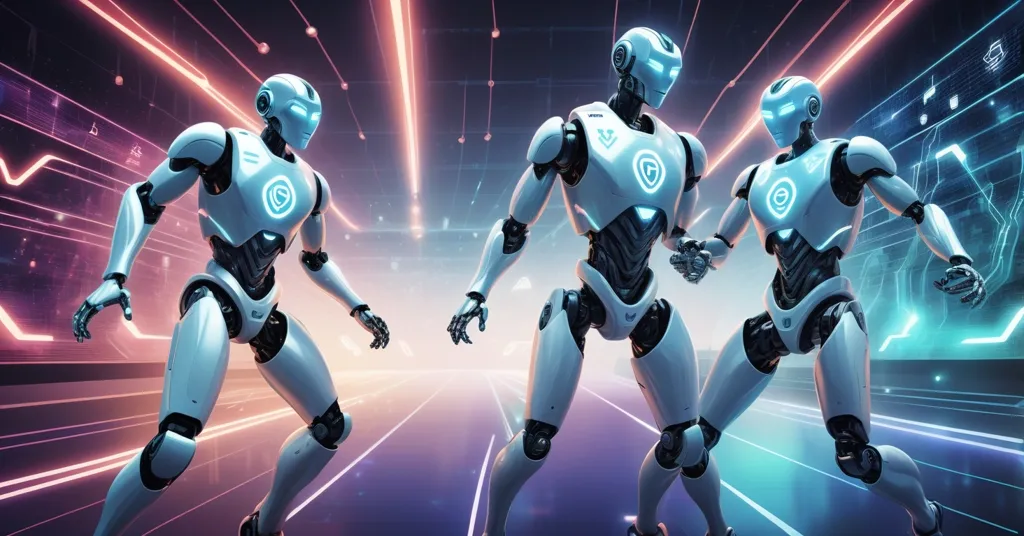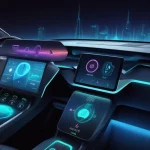Meta vs. Tesla: AI Humanoid Robot Race Heats Up with Big Tech Rivalry

Meta vs. Tesla: Who Will Win the AI Humanoid Robot Race?
Tech giants Meta and Tesla are squaring off in a fierce battle to dominate the humanoid robot market, wielding artificial intelligence as their primary weapon. This isn’t just a clash of corporate egos between Mark Zuckerberg and Elon Musk—it’s a pivotal moment that could redefine the future of work, life, and even personal freedom through physical machines powered by cutting-edge tech.
- Meta’s AI Glasses: Wearables capturing first-person video to train robots for personal tasks.
- Tesla’s Optimus: Humanoid bot learning from vast third-person data, including internet footage.
- Grand Ambitions: Musk predicts 10 billion robots by 2040; Meta chases “superintelligence.”
Meta’s Vision: From Glasses to Robots
Meta, helmed by Mark Zuckerberg, is making a bold pivot from social media and virtual reality into the gritty world of robotics. Their latest gadget, unveiled on a recent Tuesday, is a pair of AI glasses equipped with cameras in the lenses and a display screen. These aren’t just a fashion statement—they’re data-harvesting machines, capturing the world from the user’s perspective to enhance AI products and, more crucially, to train humanoid robots for everyday tasks like cooking or cleaning. Think of it as teaching a machine to see the world as you do when you’re folding laundry or chopping vegetables. Morgan Stanley analyst Adam Jonas forecasts a staggering 20 million of these glasses in use within two years, dwarfing the projected number of Tesla vehicles on the road by then.
“Every Meta glasses user may be training a humanoid avatar iterated in simulation across billions of scenarios in a digital sandbox for testing AI,” Jonas observed.
Meta’s not stopping at wearables. Through Project Aria, a specialized device for gathering AI and robotics data, they’re laying the groundwork for something much bigger. Zuckerberg has also been aggressively recruiting top talent, snagging experts like Marc Whitten, former CEO of General Motors’ self-driving unit Cruise, and Sangbae Kim, an MIT robotics professor known for building a lightning-fast “cheetah” robot. These hires scream intent: Meta wants to dominate not just the digital realm but the physical one too. Zuckerberg’s obsession with “superintelligence”—a concept where AI surpasses human intellect across all domains—drives this push, with talent packages worth hundreds of millions on the table to lure the brightest minds. For him, speed trumps caution, even if the price tag skyrockets.
“If we misspend a couple hundred billion dollars, it’s unfortunate, but building too slowly means missing out on the most transformative tech in history,” Zuckerberg admitted.
Meta’s Chief Technology Officer, Andrew Bosworth, underscored the link between these wearables and robotics, hinting at how the tech overlaps.
“An always-on AI with cameras and microphones is pretty damn close to a robot in terms of understanding the world,” Bosworth explained.
Tesla’s Play: Optimus and Data Domination
Meanwhile, Tesla, under Elon Musk’s relentless ambition, is charging ahead with its own humanoid robot, dubbed Optimus. With over 8 million self-driving cars on the road, Tesla sits on a mountain of video data—think countless hours of footage from car cameras capturing the world in third-person perspective. This isn’t just for perfecting autopilot; it’s the lifeblood of training Optimus to mimic human tasks. Unlike Meta’s intimate, user-specific approach, Tesla pulls from internet videos of people doing everything from assembling furniture to operating machinery. A recent breakthrough, as shared by former Tesla VP Milan Kovac, lets them skip manual coding by transferring learning directly from these videos to the bots.
“Our goal is for Optimus to learn straight from internet videos of humans doing tasks. We’ve had a major breakthrough in transferring that learning directly to the bots,” Kovac revealed.
Musk, never one to think small, dropped a bombshell prediction: 10 billion humanoid robots by 2040. Let’s be real—that sounds more like a headline-grabbing stunt than a concrete plan, but with Tesla’s data muscle and early prototypes of Optimus already in play, it’s not entirely laughable. That’s enough bots to form their own digital nation, or at least outvote us on social platforms. Whether it’s folding shirts or assembling cars, Tesla envisions Optimus as a ubiquitous worker, potentially reshaping entire industries. For more on this intense rivalry, check out the detailed coverage on Meta and Tesla’s competition in the AI-powered humanoid robot market.
Breaking Down the Tech for Newcomers
For those scratching their heads over the jargon, let’s simplify. Humanoid robots are machines built to look and act like humans, equipped with sensors, cameras, and AI to navigate and interact with the world. Computer vision is the tech that gives these robots “eyes,” letting them interpret visual data—like recognizing a coffee mug or a staircase. Machine learning, a core part of AI, helps them get better over time by analyzing heaps of data, whether it’s footage from Meta’s glasses (first-person, like seeing through your own eyes) or Tesla’s car cams and internet clips (third-person, like watching someone else). Meta’s approach might make robots better at personal tasks, while Tesla’s broader data pool could excel in industrial or generic roles. Both are racing to make these bots a seamless part of our lives—or a disruptive force, depending on your view.
Risks and Ethical Minefields
This isn’t just a shiny tech race; it’s a minefield of societal risks. Privacy is the elephant in the room. Meta’s AI glasses are essentially always-on surveillance tools, recording your every move to feed their algorithms. Tesla’s cars aren’t much better, hoovering up street data with little transparency on how it’s used. Remember Meta’s past data scandals, like Cambridge Analytica? That’s why “always-on” devices raise red flags. Then there’s the financial gamble—Zuckerberg himself hinted at the risk of burning billions on a misstep. If either company flops, the fallout could be a spectacular disaster, dragging investors and public trust down with it.
Let’s not ignore the bigger picture: job displacement. Studies vary, but some suggest up to 30% of current jobs could be automated by 2030 with advancements in robotics. While innovation is our bread and butter—much like Bitcoin’s disruption of finance—replacing human labor at scale could spark economic upheaval. Are we ready for a world where robots outnumber baristas? And who controls these machines? If it’s just Big Tech, we’re trading one centralized power for another, which clashes with the freedom and decentralization we champion.
The Decentralization Angle: Can Blockchain Save Us?
Here’s where our love for Bitcoin and decentralized tech kicks in. The massive datasets fueling Meta’s and Tesla’s AI training are a privacy nightmare waiting to happen. Blockchain could be the antidote, offering a way to secure this data through decentralized ownership. Imagine users controlling their personal footage via cryptographic keys, deciding who accesses it—whether it’s Meta or a robot startup. Ethereum’s smart contracts could even govern how data is shared or monetized, creating a tokenized economy where individuals, not corporations, profit from their contributions.
Bitcoin itself might play a role as a borderless payment layer for robot-driven microtransactions. Picture a future where Optimus earns sats for completing tasks in a decentralized gig economy, cutting out middlemen. Altcoins like Ethereum could further enable decentralized AI networks, preventing Big Tech from monopolizing robot infrastructure. This aligns with our push for effective accelerationism—rushing toward progress, but not at the cost of freedom or privacy. If we’re accelerating into a robot-filled future, let’s damn well ensure it’s not a dystopia ruled by centralized overlords.
Key Questions Unpacked: Meta, Tesla, and the Robot Revolution
- How are Meta and Tesla battling it out in humanoid robotics?
Meta uses first-person data from AI glasses to train robots for intimate, everyday tasks like caregiving, while Tesla relies on third-person data from car cameras and internet videos to scale learning for its Optimus robot, targeting broader industrial applications. - What gives each company an edge in this high-stakes race?
Meta’s strength is in capturing nuanced, user-specific perspectives for personalized robot behavior, while Tesla dominates with sheer data volume from millions of vehicles and a head start with Optimus prototypes. - What are the societal risks of this AI-robotics boom?
Privacy invasion from constant data collection via glasses and cars is a glaring issue, alongside the potential for mass job displacement as robots automate human roles, risking economic and social disruption. - How can blockchain technology intersect with AI robotics?
Blockchain could secure vast AI training datasets, ensuring user privacy through decentralized data control, while tokenized systems on platforms like Ethereum might let robots earn crypto for tasks in a future economy. - Does Bitcoin or crypto have a place in this tech upheaval?
Bitcoin could enable borderless microtransactions for robot services, while altcoins like Ethereum offer smart contracts to build decentralized AI networks, countering Big Tech’s grip on robotics infrastructure. - Is this race pure innovation or a Pandora’s box of chaos?
It’s a double-edged sword—AI robots promise efficiency and disruption akin to Bitcoin’s financial revolution, but unchecked development risks centralization, ethical dilemmas, and societal upheaval if privacy and power dynamics aren’t addressed.
Balancing Optimism with Hard Truths
This showdown between Meta and Tesla offers a glimpse into a future where humanoid robots could be as commonplace as smartphones. Zuckerberg’s gamble on superintelligence and Musk’s sci-fi-scale predictions of billions of bots fuel a chaotic but thrilling push toward progress—something we admire as champions of disruptive tech. Yet, while we’re all for shaking up the status quo, let’s keep our wits about us. This isn’t just innovation; it’s a tightrope walk over ethical, economic, and societal pitfalls. As we root for a world transformed by AI and robotics, much like Bitcoin transformed money, are we prepared to share it with machines that might outsmart us? One thing’s certain: the robot revolution is barreling toward us, and it’s up to us to steer it toward freedom, not control.



